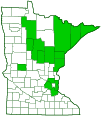fungus
(Illosporiopsis christiansenii)
Conservation • Description • Habitat • Ecology • Distribution • Taxonomy
|
|
||||||||||||||
Description |
Illosporiopsis christiansenii is a relatively common, hyphomycetous, lichenicolous fungus. It occurs in Europe and North America. In the United States it occurs from Maine to Maryland, west to Minnesota and Iowa, and in Washington state. It occurs in southern Canada from Nova Scotia to Manitoba and in British Columbia. It is relatively common in Minnesota. A lichenicolous fungus is a fungus that parasitizes lichens. Illosporiopsis christiansenii grows on the vegetative bodies (thalli) of Parmelia, Physcia and Xanthoria species, all of them lichens that grow on bark. It only grows in nutrient rich environments. It is a cool and cold season fungus. It is most common from January to early March and from October through December. It almost completely disappears in the hot summer months. Most fungi have a sexual form and an asexual form. The overall growth patterns and colony appearances can differ. Illosporiopsis christiansenii is the asexual form of a sac fungus (Ascomycota). The sexual form has not been identified. A hyphomycetous fungus is a fungus that lacks a closed fruit body. The term does not define a phylogenetic group, and it does not appear in any taxonomic hierarchy, but it is still practical for identification purposes. The fruiting body (sporodochium) of Illosporiopsis christiansenii is a 1⁄64″ to 1⁄32″ (0.5 to 1.0 mm) in diameter, 1⁄265″ to 1⁄16″ (0.1 to 2 mm) high, bright, intensely pink, dense blob of asexual spores (conidia). Adjacent sporodochia often merge together into a much larger blob containing thousands of conidia. When dropped in water, the blob appears to dissolve as the spores are washed away. The conidia have a characteristic spiral appearance. This is only visible under a microscope with a 1,000x magnification. |
Similar Species |
Marchandiomyces corallinus forms bulbils. The pink color is less intense, and the bulbils do not appear to dissolve in water. The conidia are not coiled. |
Habitat and Hosts |
Nutrient rich environments wherever the host lichens are found Parmelia, Physcia and Xanthoria species |
Ecology |
Season |
January to early March and from October through December |
Distribution |
||
|
Sources |
|
| 1/13/2025 | ||
Occurrence |
||
Relatively common in Minnesota |
||
Taxonomy |
|
Kingdom |
Fungi (Fungi) |
Subkingdom |
Dikarya |
Phylum |
Ascomycota (Sac Fungi) |
Subphylum |
Pezizomycotina (Sac Fungi and Lichens) |
Class |
Sordariomycetes |
Subclass |
Hypocreomycetidae |
Order |
Hypocreales |
Family |
Incertae sedis |
Genus |
Illosporiopsis |
|
|
This species was originally described in 1986 as Hobsonia christiansenii. A recent molecular phylogenetic analysis of Hobsonia and similar genera (Sikaroodi et al., 2001) showed that the three Hobsonia species were not related. New genera were erected for two of those species. Hobsonia christiansenii became Illosporiopsis christiansenii. |
|
Subordinate Taxa |
|
|
|
Synonyms |
|
Hobsonia christiansenii |
|
Common Names |
|
This species has no common name. |
|
Glossary
Conidium
An asexual spore produced by some fungi. Plural: conidia.
Thallus
In lichens: The vegetative body of a lichen composed of both the alga and the fungus. In liverworts: a flat, relatively undifferentiated plant body. Plural: thalli.
Visitor Photos |
||
Share your photo of this fungus. |
||
This button not working for you? |
||
Luciearl |
 |
The lichen colors pop out after it rains. I don't think I'be seen pink before but found tiny amounts on several branches. |
MinnesotaSeasons.com Photos |
||
|
||
|
||

Slideshows |
|

Visitor Videos |
||
Share your video of this fungus. |
||
This button not working for you? |
||
|
Other Videos |
||
|

Visitor Sightings |
||
Report a sighting of this fungus. |
||
This button not working for you? |
||
Luciearl |
Location: Lake Shore, MN The lichen colors pop out after it rains. I don't think I'be seen pink before but found tiny amounts on several branches. |
 |
MinnesotaSeasons.com Sightings |
||
|

|
Created: 1/13/2025 Last Updated: © MinnesotaSeasons.com. All rights reserved. |
